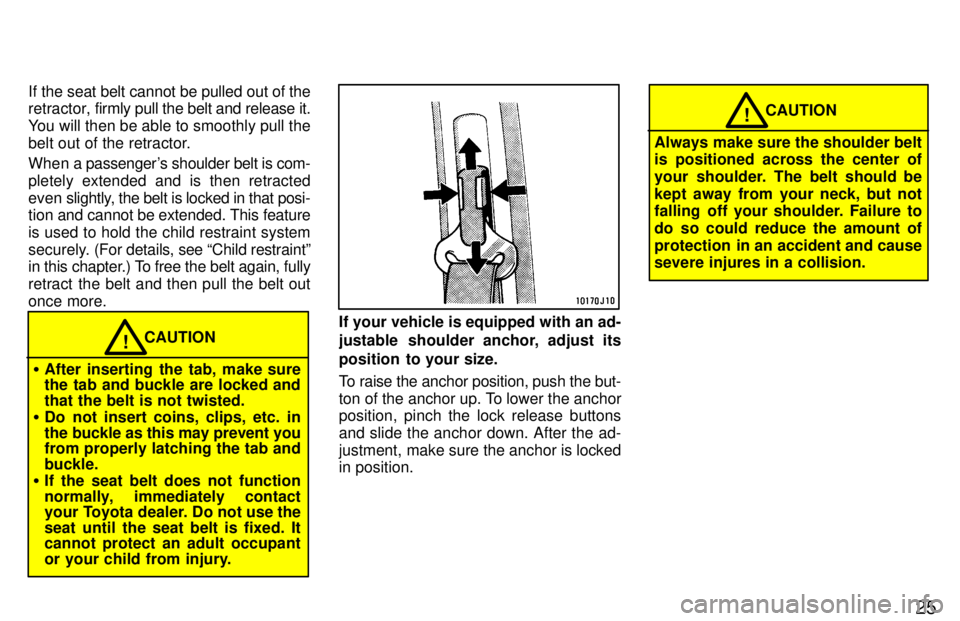Page 10 of 159
Indicator symbols on the instrument panel5
Anti-lock brake system warning light * 1
Brake system warning light * 1
Seat belt reminder light* 1
Low oil pressure warning light* 1
Malfunction indicator light* 1
SRS airbag warning light* 1
Automatic transmission fluid
temperature warning light*
1 Turn signal indicator lights
Headlight high beam indicator light
Over-drive indicator light
Open door warning light * 1
Unengaged Parkºwarning light * 1
PWRº mode indicator light
Automatic transmission second
start indicator light Center Differential lock indicatorlight
Front Differential lock indicator light
Rear Differential lock indicatorlight
Page 11 of 159
6
Cruise control indicator light*3
*1
: For details, see Service reminder indicators and warning
buzzersº in Chapter 1-5. * 2
: If this light flashes, see Automatic transmissionº in Chapter 1-6.
*3 : If this light flashes, see Cruise controlº in Chapter 1-6.
Automatic transmission indicator lights
Page 13 of 159
18
ADJUSTING SEAT POSITION
Pull the lock release lever up. Then
slide the seat to the desired position
with slight body pressure and release
the lever.
ADJUSTING SEATBACK ANGLE
Lean forward and pull the lock release
lever. Then lean back to the desired
angle and release the lever.
CAUTION!
To reduce the risk of sliding under
the lap belt during a collision, avoid
reclining the seatback any more than
needed. The seat belts provide maxi-
mum protection in a frontal or rear
collision when the driver and the
passenger are sitting up straight and
well back in the seats. If you are re-
clined, the lap belt may slide past
your hips and apply restraint forces
directly to the abdomen. Therefore,
in the event of a frontal collision, the risk of personal injury may increase
with increasing recline of the seat- back.
ÐAdjusting front seats
(power type)
ÐAdjusting front seats(manual type)
Page 21 of 159

25
If the seat belt cannot be pulled out of the
retractor,
firmly pull the belt and release it.
You will then be able to smoothly pull the
belt out of the retractor.
When a passenger's shoulder belt is com-
pletely extended and is then retracted
even slightly, the belt is locked in that posi-
tion and cannot be extended. This feature
is used to hold the child restraint system
securely. (For details, see Child restraintº
in this chapter.) To free the belt again, fully
retract the belt and then pull the belt out
once more.
CAUTION!
� After inserting the tab, make sure
the tab and buckle are locked and that the belt is not twisted.
� Do not insert coins, clips, etc. in
the buckle as this may prevent you
from properly latching the tab and buckle.
� If the seat belt does not function
normally, immediately contact
your Toyota dealer. Do not use the
seat until the seat belt is fixed. It cannot protect an adult occupant
or your child from injury.
If your vehicle is equipped with an ad-
justable shoulder anchor, adjust its
position to your size.
To raise the anchor position, push the but-
ton of the anchor up. To lower the anchor position, pinch the lock release buttons
and slide the anchor down. After the ad-
justment, make sure the anchor is locked
in position.
CAUTION!
Always make sure the shoulder belt
is positioned across the center of
your shoulder. The belt should be
kept away from your neck, but not
falling off your shoulder. Failure to
do so could reduce the amount of
protection in an accident and cause severe injures in a collision.
Page 26 of 159

30
This indicator comes on when the
ignition key is turned to the ACCº or
ONº position. It goes off after about 6
seconds. This means the SRS airbag
is operating properly.
The SRS airbag warning light system
monitors the airbag sensor assembly, in-
flators, warning light, interconnecting wir-
ing and power sources.The SRS airbag system is designed to
activate in response to a severe frontal
impact within the shaded area be-
tween the arrows in the illustration.
The SRS airbags will deploy if the severity
of the impact is above the designed
threshold level, comparable to an approxi-
mate 20 km/h (14 mph) collision when im-
pacting straight into a fixed barrier that
does not move or deform.
If the severity of the impact is below the
above threshold level, the SRS airbags
may not deploy. However, this threshold velocity will be
considerably higher if the vehicle strikes
an object, such as a parked vehicle or sign
pole, which can move or deform on im-
pact, or if it is
involved in an underride col-
lision (e.g. a collision in which the noise of
the vehicle underridesº, or goes under, the bed of a truck). It is possible with collision severity at the marginal level of airbag sensor detection
and activation that only one of your ve-
hicle's two airbags will deploy.
For the safety of all occupants, be sure to
always wear seat belts.
Page 30 of 159

34
Failure to follow these instructions
can result in severe injuries.
NOTICE
Do not perform any of the following changes without consulting your
Toyota dealer. Such changes caninterfere with proper operation of the SRS airbag system in somecases.
�Installation of electronic itemssuch as a mobile two-way radio,
cassette tape player or compactdisc player
�Modification of the suspension
system
�Modification of the front endstructure
�Attachment of a grille guard (bullbar, kangaroo bar, etc.), snow-
plow, winches or any other equip-ment to the front end
�Repairs made on or near the front
end structure, console, steeringcolumn, steering wheel or dash-board near the front passenger
airbag.
This SRS airbag system has a service re-
minder indicator to inform the driver of op-
erating problems. If either of the following
conditions occurs, this indicates a mal-
function of the airbags. Contact your To-
yota dealer as soon as possible to service
the vehicle. � The light does not come on when the
ignition key is turned to the ACCº or
ONº position, or remains on.
� The light comes on while driving.In the following cases, contact your Toyo-
ta dealer as soon as possible: �The SRS airbag has been inflated.
� The front part of the vehicle (shaded in the illustration) was involved in an ac-
cident not of the extent to cause the
SRS airbags to inflate
� The pad section of the steering wheel
(shaded in the illustration) is scrat-
ched, cracked, or otherwise damaged.
Page 32 of 159
51
To adjust a power rear view mirror, first
place the master switch at Lº (left) or
Rº (rightº depending on which mirror
needs adjusting, then push the con-
trol switch in the desired direction.
If the engine is not running, the key must be in the ACCº position.
NOTICE
If ice should jam the mirror, do not operate the control or scrape the
mirror face. Use a spray de-icer tofree the mirror.
To fold the rear view mirror, push back-
ward.
The rear view mirrors can be folded back-
ward for parking in restricted areas.Pull the lever toward you to reduce glare from the headlights of the ve-
hicle behind you during night driving.
Before adjusting the mirror to the position
with most clarity, push the day-night
charge lever away from you (daylight driv-
ing position). Remember that by reducing glare you
also lose some rear view clarity.
ÐFolding rear view mirrors
Anti-glare inside rear view mirror
ÐPower
rear view mirror control
Page 33 of 159
52
To use the vanity mirror, swing down
the sun visor and open the cover.
The vanity light comes on when you open
the cover.Vanity mirrors